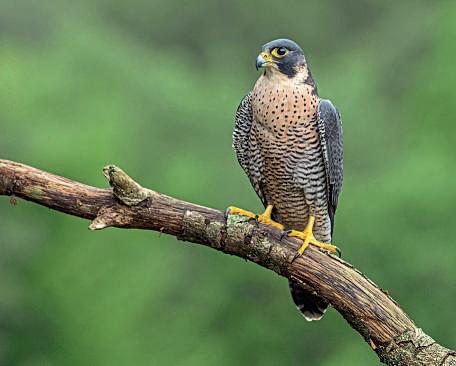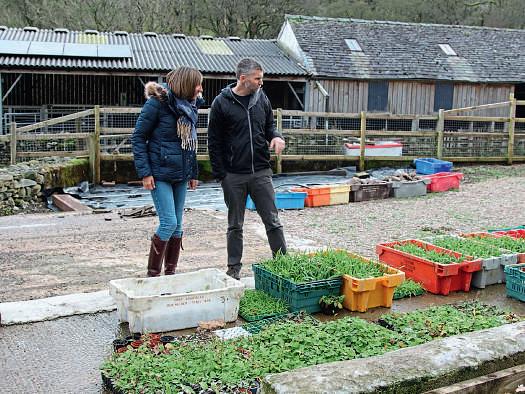
8 minute read
Plant a tree with LOFA in the Lake
Pied fly-catchers, peregrine falcons and redstarts (below) and are among the birds flourishing in Haweswater.



SOLEX visitors fund new conservation habitats in the Lake District
Thanks to visitors of SOLEX, more than £7000 was raised to buy trees for the RSPB Haweswater reserve in Penrith. Gina Hinde, LOFA Marketing Manager, visited in November to see where the trees will be planted and how they will benefit local wildlife and the environment.
Working for LOFA, I never know what each day will bring, but I do get to meet a lot of lovely people and often find myself in rather wonderful places.
On a sunny autumn day in November, I headed northwards to a place I had only read about, Haweswater on the eastern edge of the Lake District. The reason for my visit was to follow up the Plant a Tree with LOFA campaign where we pledged £5 to the RSPB for each person visiting the Summer Outdoor Living Exhibition 2022. We raised more than £7000 and lucky me, I was invited to meet Lee Schofield, Senior Site Manager, to see where our trees are going to be planted.
Naddle Farm in Penrith is approached by a private road hidden away from prying eyes and as I stepped out of the car the heavens opened. I had arrived at the headquarters forthe heavens opened. I had arrived at the headquarters for RSPB Haweswater, early as usual, and was invited into a verRSPB Haweswater, early as usual, and was invited into a very y cosy conference room to have a cup of tea and a chat withcosy conference room to have a cup of tea and a chat with Lee about his work. He has been working for the RSPB forLee about his work. He has been working for the RSPB for 10 years and is the most passionate and knowledgeable guy10 years and is the most passionate and knowledgeable guy I think I’ve ever met; he has even written a book calledI think I’ve ever met; he has even written a book called WildWild Fell, available in all good book shops, about his work and the, a e in all good book shops, ut his w k and the wonderful work being carried out at the site.wonderful work being carried out at the site.
A little slice of heaven

Haweswater, including the reservoir, is owned by the water company United Utilities, the reservoir supplies two million people with drinking water. The RSPB have been working here since the 1960’s. The partnership developed in the eighties and as time went on it became clear to both parties, they wanted the same thing for the land. So, in 2012, the RSPB took on a 45-year tenancy to manage Naddle and Swindale farms along with the grazing rights on Mardale, Bampton, Rosgill and Ralfland Commons.
Once the tea was drunk, Lee took me on a guided tour of the site. Both Naddle and Swindale are working farms and are slowly being improved and developed. Lee showed me the sheep sheds that have been turned into a tree and plant nursery where cuttings taken from the land are cared for and grown to re plant and regenerate the land.
Haweswater, which extends to 30 square kilometres is not on the tourist map of the Lake District and it does look like it’s been deserted by humans, but this place has vital connections to people’s lives.
We hopped back into our cars, and I followed Lee to the area where our trees are being planted and it literally took my breath away. It is a little slice of heaven surrounded by looming fells within a glacially carved landscape. There is a beck flowing through the centre and it’s studded with mossy woodland. Even on a rainy day in November the place is exceptionally beautiful.
Full of Lake District grandeur Haweswater is breath-taking, but when you look a little closer, Lee said, ecological issues stand out. , including the reservoir, is owned by the water company United Utilities, the reservoir supplies two million people with drinking water. The RSPB have been working here since the
people’s lives. We hopped back into our cars, and I followed Lee to the area where our trees are being planted and it literally took my breath away. It is a little slice of heaven surrounded by looming fells within a glacially carved landscape. There is a beck fl owing through the centre and it’s studded with mossy woodland. Even on a rainy day in November the place is exceptionally beautiful. Full of Lake District grandeur Haweswater is breath-taking, but when you look a little closer, Lee said, ecological issues stand out.
RestorationRestor
Intensive grazing has meant open common land and enclosede g ng s m t open common land and enc farmland are not in great shape, dominated by species- are not in t s domi ed by speci
Gina and Lee at Haweswater poor acid grassland and bracken with large areas of peat bog drained to try and improve them for farming. This has reduced the bog’s vital water and carbon storage capacity creating a whole host of problems for people and nature. Through the valley runs Swindale Beck which until recently ran as a straight as a canal, having been engineered to drain surrounding farmland some 200 years earlier. This created unintended consequence of increasing flood risks for people downstream as well as robbing the land of its value to wildlife.
Having the bends put back in the Swindale Beck means it now meanders naturally through the colourful meadows which provide flowery hay for the livestock during the winter months. Now free from manmade constraints the beck can also spill out onto the floodplain and will change its course as natural rivers do. The gravelly bed can again be the spawning ground for salmon and banks will be home to water voles, otters and kingfishers and through, the careful management of deer, there will be a healthy mix of young and old trees. These woodlands are our native rainforests and by enabling them to spread will ensure species such as tree lungwort, lichen and pied flycatchers will have a secure long-term future
Ecological restoration is a slow process, anyone who works in horticulture will know that nature can’t be hurried. This project started back in 2012 with the planting and regeneration of trees. I didn’t realise but bracken is nature’s marker of where trees would have historically grown and covered the landscape and as you travel around the Lake District you can see how many trees have disappeared. Lee and his team have removed fences allowing the boundaries between woods, heath bogs and grassland to become blurred creating a more diverse set of conditions for wildlife. More trees will be planted to benefit the livestock with natural shade and shelter and more hedgesthe livestock with natural shade and shelter and more hedges will provide vital habitat for wildlife and help with livestockwill provide vital habitat for wildlife and help with livestock management. By blocking drains and re-vegetating areas,management. By blocking drains and re-vegetating areas, the bogs will be wet and wild, which meansthe bogs will be wet and wild, which means the flow of water through the landscapethe fl ow of water through the landscape will be slower, encouraging the growthwill be slower, encouraging the growth of healthy moss locking in thatof healthy moss locking in that all imporall important carbon from thetant carbon from the atmosphere as they grow. Byatmosphere as they grow. By 2050 they will have shown2050 they will have shown this approach is as good forthis approach is as good for people as it is for nature. Our funding will help plant much needed hawthorne trees along the valley helping to reduce the carbon footprint of the SOLEX exhibition, and, much more importantly creating a home for wildlife. I have seen first-hand where our money is being spent and what a fantastic difference it is going to make to this wonderful site. Lee told me of plans to develop the site over the coming years. Sustainable farming, the tree nursery, wildlife hides, accommodation, education, scientific research, and a range of activities will provide an array of diverse employment and volunteering opportunities, which in turn will help support local communities.
“Working at Haweswater over the next 40 years will mean working with change,” says Lee. “Much of that change will be driven by big external factors – climate, politics and shifts in the land economy - that are beyond our control. But how we respond to change is within our control, and in that, we see opportunities for Haweswater. Opportunities in what Haweswater can do for society and for the livelihoods it can sustain as a result. And opportunities for nature to be even more vital and inspiring: resurgent alpine and floodplain meadows, juniper on the fellsides, salmon in the rivers, healthy ancient woods, and the hum of insects and birdlife that will follow.”
So, this is a big THANK YOU from LOFA to those that visited SOLEX 22, you have helped this amazing project and the environment.

Find out more
If you want to make a difference again next year and help with this vital ecological restoration and give nature a home, then please visit SOLEX 23.
Sheep pens are now being turned into a plant nursery to help with replanting and restoration
Views of Haweswater’s looming fells and mossy banks

SOLEX. 10-12 July 2023 Hall 5, NEC, Birmingham. Solexexhibition.com Lofa.co.uk Rspb.org.uk











